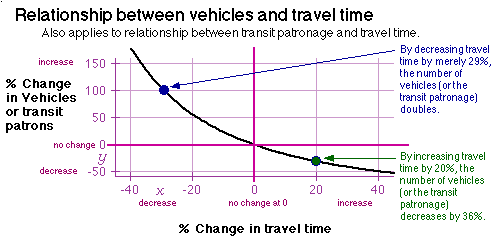Induced traffic:
Why Measure B won't solve traffic congestion
Increasing highway capacity increases auto usage, and the same congestion as today returns soon (in as little as two years) after construction. It does not decrease congestion in the long term. This effect is called induced traffic.
The gravity transportation model is used by government agencies to predict future traffic. It relates the number of vehicles and the travel time. Decreasing travel time increases the vehicles and returns the congestion. The graph below shows the relationship and why the congestion returns.
Real solutions to traffic congestion
Our web sites details real solutions for traffic congestion. For example, see Solutions for traffic congestion by the Modern Transit Society.
